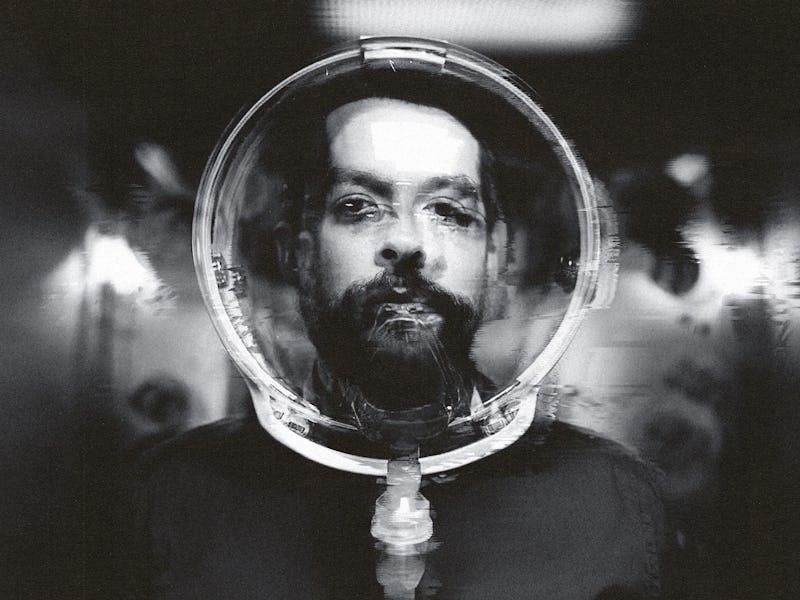The Most Prophetic Sci-Fi Movie of the Decade Is Impossible to Watch Online
The Dog Who Wouldn’t Be Quiet is an absurdist masterpiece with a shocking final act.

Near the end of the brisk 73-minute runtime of The Dog Who Wouldn’t Be Quiet (El perro que no calla), a sequence executed in hand-drawn sketches shows a meteorite landing on Earth. The event alters our access to oxygen. Now, the vital gas only exists up to 4 feet above the ground, which means people either have to squat walk or wear an astronaut-like bubble helmet to be able to stand upright. The farcical sci-fi conceit packs a deeper meaning that reminds us how even during 2020, profits came before safety.
But by the time this collective setback occurs, Sebastián (Daniel Katz, the director’s brother), an unremarkable man in his 30s living in Buenos Aires, has already undergone multiple life-altering transitions set in motion by the desire to stay true to himself. Released in 2021 but filmed before the global shutdowns of 2020, this existentialist tragicomedy from filmmaker Ana Katz subtly contemplates the forces that shape our destinies and how we confront them. Her black-and-white gem deals with both powerlessness and perseverance.
Several of Sebás’ distressed neighbors show up at his door one day to complain about his dog, Rita, who, according to them, cries nonstop while he is at work, though we never actually hear a peep from Rita, which adds to the tale’s absurdism. Loneliness, they all think, is the cause of the animal’s suffering. So Sebás starts bringing the pet to his office job as a graphic designer. But his superiors are not pleased with Rita’s presence, if only because it opens the door for other employees to bypass the rules of conduct. (Capitalism expects us to live our lives in the brief cracks of time between productivity and the burden of mundane tasks.) Sebás gets an ultimatum: Either the dog stays home, or he will be fired. He quits on the spot.
Each subsequent brief chapter after this turning point, oscillating between melancholy and amusement, takes Sebás in spur-of-the-moment directions: a stint working the land in the countryside, returning to live with his mother in the city, finding part-time work caring for a man with a cognitive illness, or becoming part of a farming cooperative where he finally feels fulfilled (if only for a while). The passage of time — months and even years — is marked by Sebás’ distinct hairstyles. He eventually settles with a romantic partner and becomes a father during the time of the oxygen crisis. And it’s then that the bubble helmets raise an issue of class. Only those with substantial funds have access to them. Their value, a sense of normalcy, gives the wealthy an advantage and makes others desperate enough to steal them.
The dog in question.
Brimming with an endearing timidness, Daniel Katz’s performance affirms that Sebastián is neither defeated nor overly confident. He moves swiftly with life’s changes, trying to land on his feet but conscious that he can’t be tied too strongly to any one version of himself. Sebás embraces life as something beautifully malleable and doesn’t sink in the face of uncertainty. That’s admirable. His loyal affection for Rita served as the catalyst for him to scrap any image of his future he may have built and start from scratch multiple times over, venturing into the terrifying unknown to figure out how to hold on to happiness.
The Dog Who Wouldn’t Be Quiet is the sixth feature from Ana Katz, who is prolific as a director, and even more so as an actor, and is perhaps her most formally adventurous. As with the meteorite, Katz employs rough sketches crafted by production designer Mariela Rípodas (at times animated in rudimentary fashion) to get across moments too painful or too costly to shoot or create with VFX. These hand-drawn segments feel in harmony with the film’s unassuming charm. Co-penned with Gonzalo Delgado and shot by five different cinematographers, Katz’s most recent piece of unconventional cinema captures profoundly thought-provoking reflections in a succinct and unsanctimonious vessel, which makes it all the more praiseworthy. The nagging pup the title alludes to ultimately symbolizes that within us that propels us to strive for something soul-nourishing during our limited time here.
Although The Dog Who Wouldn't Be Quiet premiered at the Sundance Film Festival in 2021 to a warm reception, the movie is currently unavailable to stream, rent, or buy in the United States. It enjoyed a brief run on Mubi but has since lost to the vertiginous and unforgiving content churn that rarely favors idiosyncratic international titles. Hopefully, like its protagonist, the movie will find another chance at being properly discovered stateside soon.